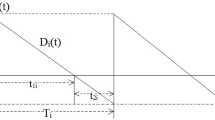Abstract
In this study, we consider a fuzzy inventory model of type (s,S) with random demands having an inverse Gaussian distribution. We first show the monotonicity of the renewal function with respect to mean parameter. Thus we obtain the membership function of the fuzzy renewal function when the amount of demands is a random variable having an inverse Gaussian distribution with a fuzzy mean parameter by using the monotonicity property of renewal function. Making use of the membership function of the renewal function, we obtain the membership function of the fuzzy ergodic distribution of this process. We also present some numerical results obtained by using this membership function.







Similar content being viewed by others
References
Artalejo JR, Krishnamoorthy A, Lopez-Herrero MJ (2006) Numerical analysis of (s,S) inventory systems with repeated attempts. Ann Oper Res 141(1):67–83
Chhikara RS, Folks JL (1989) The inverse Gaussian distribution. Marcel Dekker, New York
Derieva EN (2004) A control model for an insurance company. Cybern Syst Anal 40(6):936–938
Doksum KA, Hbyland A (1992) Models for variable-stress accelerated life testing experiments based on wiener processes and the inverse gaussian distribution. Technometrics 34(1):74–82
Durham SD, Padgett WJ (1997) Cumulative damage models for system failure with application to carbon fibers and composites. Technometrics 39(1):34–44
Folks JL, Chhikara RS (1978) The inverse Gaussian distribution and its statistical application—a review. J R Stat Soc. Series B (Methodological) 40(3)263–289
Gavirneni S (2001) An efficient heuristic for inventory control when the customer is using a (s,S) policy. Oper Res Lett 28(4):187–192
Gökpınar EY, Polat E, Gokpınar F, Günay S (2013) A new computational approach for testing equality of inverse Gaussian means under heterogeneity. Hacet J Math Stat 42(5):585–590
Hong DH (2006) Renewal process with T-related fuzzy inter-arrival times and fuzzy rewards. Inf Sci 176(16):2386–2395
Khaniyev T, Turksen IB, GokpinarF Gever B (2013) Ergodic distribution for a fuzzy inventory model of type (s,S) with gamma distributed demands. Expert Syst Appl 40(3):958–963
Kim MS, Sarkar B (2017) Multi-stage cleaner production process with quality improvement and lead time dependent ordering cost. J Clean Prod 144:572–590
Li S (2011) Some properties of fuzzy alternating renewal processes. Math Comput Model 54(9):1886–1896
Moon I, Shin E, Sarkar B (2014) Min–max distribution free continuous-review model with a service level constraint and variable lead time. Appl Math Comput 229:310–315
Nasirova TI, Yapar C, Khaniyev TA (1998) On the probability characteristics of the stock level in the model of type (s,S). Cybern Syst Anal 5:69–76
Pramanik T, Samanta S, Sarkar B, Pal M (2016) Fuzzy φ-tolerance competition graphs. Soft Comput. https://doi.org/10.1007/s00500-015-2026-5
Sarkar B (2012) An EOQ model with delay in payments and time varying deterioration rate. Math Comput Model 55(3):367–377
Sarkar B (2013) A production-inventory model with probabilistic deterioration in two-echelon supply chain management. Appl Math Model 37(5):3138–3151
Sarkar B (2016) Supply chain coordination with variable backorder, inspections, and discount policy for fixed lifetime products. Math Probl Eng. https://doi.org/10.1155/2016/6318737
Sarkar B, Majumder A (2013) Integrated vendor–buyer supply chain model with vendor’s setup cost reduction. Appl Math Comput 224:362–371
Sarkar B, Saren S (2016) Product inspection policy for an imperfect production system with inspection errors and warranty cost. Eur J Oper Res 248(1):263–271
Sarkar B, Sana SS, Chaudhuri K (2011) An imperfect production process for time varying demand with inflation and time value of money—an EMQ model. Expert Syst Appl 38(11):13543–13548
Sarkar B, Cárdenas-Barrón LE, Sarkar M, Singgih ML (2014) An economic production quantity model with random defective rate, rework process and backorders for a single stage production system. J Manuf Syst 33(3):423–435
Sarkar B, Ganguly B, Sarkar M, Pareek S (2016) Effect of variable transportation and carbon emission in a three-echelon supply chain model. Transp Res E Logist Transp Rev 91:112–128
Schrödinger E (1915) Zur theorie der fall-und steigversuche an teilchen mit brownscher bewegung. Physikalische Zeitschrift 16(1915):289–295
Seshadri V (1993) The inverse Gaussian distribution: a case study in exponential families. Cleredon Press, Oxford
Seshadri V (1999) The inverse Gaussian distribution: statistical theory and applications. Springer, New York
Sett BK, Sarkar B, Goswami A (2012) A two-warehouse inventory model with increasing demand and time varying deterioration. Sci Iran 19(6):1969–1977
Tian L (2006) Testing equality of inverse Gaussian means under heterogeneity, based on generalized test variable. Comput Stat Data Anal 51(2):1156–1162
Tweedie MCK (1945) Inverse statistical variates. Nature 155:453
Wald A (1947) Sequential analysis. Wiley, New York
Wang X (2011) Continuous review inventory model with variable lead time in a fuzzy random environment. Expert Syst Appl 38(9):11715–11721
Wang S, Watada J (2009) Fuzzy random renewal reward process and its applications. Inf Sci 179(23):4057–4069
Wang S, Liu YK, Watada J (2009) Fuzzy random renewal process with queueing applications. Comput Math Appl 57(7):1232–1248
Zhao R, Tang W, Yun H (2006) Random fuzzy renewal process. Eur J Oper Res 169(1):189–201
Author information
Authors and Affiliations
Corresponding author
Rights and permissions
About this article
Cite this article
Khaniyev, T., Gökpınar, F., Hanalioglu, T. et al. On the Stationary Distribution for a Fuzzy Inventory Model of Type (s,S) with Inverse Gaussian Distributed Demands. Iran J Sci Technol Trans Sci 42, 2035–2043 (2018). https://doi.org/10.1007/s40995-017-0363-1
Received:
Accepted:
Published:
Issue Date:
DOI: https://doi.org/10.1007/s40995-017-0363-1




